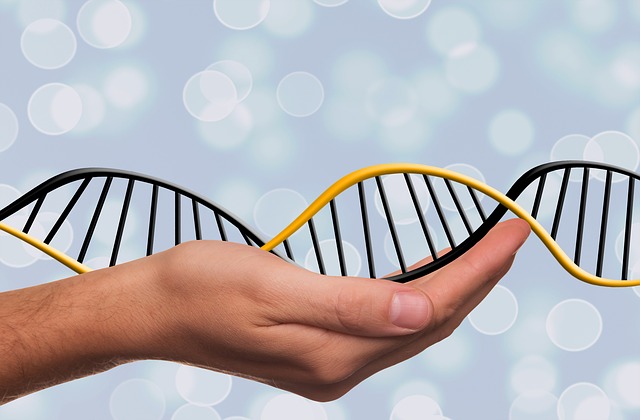
‘Three parents babies’ is a very exhilarating concept to prevent some inherited diseases. Inherited diseases have direct linked up with genetic disorders due to abnormalities involves single or multiple genomes. Underlying genetic changes are the cause of such type of diseases.
In April 2016, a baby boy born in Mexico is one of the first successful intentional “three-parent” babies. The term three parents is used due to the birth of such children involves a bonus DNA obtained from a female donor is used along with the biological parents of the child. This reproduction process is considered a reproductive medicine for children who have genetically diseased parents.
Contents
- Definition of genetic disease.
- Details of genetic disease transmission involve in mtDNA mutation.
- Genetic disease transmission
- Evaluation of ‘three-parent reproductive option’ for treating genetic disorder?
- Biological challenges in mitochondrial gene replacement for three parenting options.
- Ethical challenges in mitochondrial gene replacement for three parenting options.
- Conclusion.
Definition of ‘babies with three parents’
“Three-parent” baby carries a DNA blend, which is made up of a mother’s DNA, father’ DNA and DNA from a female donor who has no familial genetic relationship with the child. The reproductive technique is also known as mitochondrial replacement therapy.
Definition of genetic disease
An abnormal genetic mutation associated with an inherited disease condition is termed a genetic disease. The cellular protein abnormal instruction is the pathophysiology involved in genetic disease. Genetic disorders are several different types based on the risk associated with the inheriting transmission of the disease through the next generation and complications of pregnancy.
Risks of genetic disease transmission may be increased in the following cases:
- Already previous child suffering from genetic disorders.
- Familial history of a genetic disorder.
- Either parent already diagnosed with a chromosomal abnormality.
- A prenatal ultrasound report shows fetus abnormality.
The classification of genetic disorders are as follows:
- Single gene defects
- Chromosomal abnormalities
- Multifactorial problems
- Teratogenic problems
Details of genetic disease transmission involve in mtDNA mutation
Before we discuss mitochondrial replacement therapy, it is necessary to know how mitochondrial mutation leads to genetic disease. Mitochondria are also known as ‘powerhouse of the cell’ as it stores and supplies energy in the form of ATP. oxidative phosphorylation is a mitochondrial functioning through which ATP is generated. Mitochondrial disease occurs due to mtDNA mutation or nuclear DNA become mutated which is involved in mitochondrial function. Moreover, some chronic-metabolic disorders develop with aging including diabetes, Parkinson’s Disease or cardiovascular disease also trigger mtDNA mutations and this condition is termed as acquired mtDNA mutation.
The actual global incidence rate of mtDNA mutation is still unknown. But Western countries like in the USA the estimated mtDNA mutation affected birth rate is1: 4,000. Brain, liver, heart, muscle, or other high energy-requiring tissues are generally affected by mitochondrial disease. Many diseases are enlisted under mitochondrial disease conditions having multiple varieties of symptoms, including blindness, deafness, muscle weakness, diabetes, heart, liver, and kidney failure. But the heterogeneous nature of these disease conditions difficult to label under a specific clinical syndrome. 37 genes are present in the mitochondrial genome and every child inherited mtDNA from a maternal source. Thousand of mtDNA copies are present in every cell.
There are two types of mtDNA mutations- homoplasmic and heteroplasmic. All copies mtDNA are mutated in case of homoplasmic mtDNA gene mutation, whereas, heteroplasmic mtDNA has a mixture of mutated and wild-type DNA. Heteroplasmic mtDNA was common in mitochondrial disease affected patients. There are very few treatment options available for the mitochondrial disease condition. Therefore, preventive intervention is considered the best treatment approach. Preventive intervention usually involves in restriction of maternally inherited mitochondrial disease transmission to offspring.
The Requirement of Genetic counseling
The transmission of genetic disease through mtDNA has a complex mechanism and yet now not fully understood. Selective genome replication and genetic bottleneck are two complicated processes involve in the heteroplasmic mtDNA transmission. Offsprings of heteroplasmic mothers have significant variant levels of mutated mtDNA. A heteroplasmic woman having a low level of mutated mtDNA can transmit a much greater level of genetic mutation to her offspring through the mitochondrial bottleneck.
Genetic counseling is very important before planning for pregnancy. The involved genetic risk associated with spontaneous or assisted reproduction techniques and the limitation of prenatal and pre-implantation testing is discussed during genetic counseling. MtDNA disease identification is difficult through pre-implantation genetic diagnosis, as heteroplasmy and genetic bottleneck related uncertainty interfere with the inference of diagnostic test reports. Mutation load also difficult to predict in an entire embryo developmental stage. It is also difficult to medically conclude the disease outcome in association with mutation load in terms of severity.
Pre-implantation genetic diagnosis is not an optimum treatment approach for eliminating the risk of abnormal mtDNA transmission. It may only reduce the incidence rate of mitochondrial disease in subsequent generations by diagnosing the condition.
A whole oocyte donation is an option for women having high levels of heteroplasmic mtDNA mutations to ensure an unaffected child born. But, this may not be well accepted as very links present between the mother and the child. The ‘three-parent reproductive option’ is an alternative approach to prevent genetic disease transmission, as it offers mitochondrial genome substitution between gametes or embryos.
Evaluation of ‘three-parent reproductive options for treating genetic disorder?
Donor involvement in infertility treatment is common in the case of infertile couples. But in recent days, medical science conducted different research to treat genetic disorders by creating a link between biological parents with donors. There are multiple scientific approaches yet now developed, which helps to evolve and establish the current three parents’ reproductive treatment options to prevent genetic disease. These are as follows:
Transmission of mtDNA can be possible through cytoplasmic transfer. The first cytoplasmic transfer related pregnancy was reported in 1997. A little amount of ooplasm is transferred from one oocyte to another in the cytoplasmic transfer technique. In this process, mutated mtDNA does not remove, unable to prevent mitochondrial disease transmission. But adding of donor mitochondria can create a heteroplasmic oocyte with both mitochondrial haplotypes. But in this process, the amount of healthy mtDNA transmission is very less.
Pronuclear transfer and spindle transfer are two recent reproductive treatment development, which is more promising to treat the genetic disorder. In these techniques the mtDNA of the offspring exclusively derived from healthy donor’s oocyte, while they inherited nuclear genetic material obtained from both the parents. these techniques bring out the concept of ‘ Three parents reproductive option’. This option not only prevents mitochondrial disease to the resulting child but also in subsequent generations.
In pronuclear transfer, both pronuclei remove from a fertilized ovum containing mtDNA mutations and reconstruct by transferring them to the perivitelline space of a donated fertilized enucleated (cell without a nucleus) ovum. The reconstructed ovum contains the nuclear DNA material collected from the mother’s oocyte and cytoplasm and mtDNA from the donor’s oocyte. The animal model showed successful normal offspring birth by opting for this method. But recent researchers reported abnormal fertilization results by opting the pronuclear transfer technique. They found complete ( 8.3% development) in blastocysts stage due to insufficient mtDNA carryover rate. Therefore, this method is not practically applicable.
But finally, clinical researchers got success with spindle transfer, the alternative approach of reproductive treatment development. In the spindle transfer technique, the spindle with attached chromosomal material is collected from the donated unfertilized oocytes and then transfer it to the maternal oocyte, which has no own nuclear material through micromanipulation process. Then in-vitro fertilization is conducted with reconstituted oocyte and sperm tissue collected from the father semen and allows for embryo development. The efficiency of this technique was first tested in a non-human primate model and obtained a successful result by giving healthy offspring birth.
Biological challenges in mitochondrial gene-replacement for three parenting option
The fundamental principle that lies in three parenting concepts involves mitochondrial genetic material replacement. In this technique, the main challenges are germline modifications and the transmission of the modification to the subsequent generations. Research related interventions are applied in the participants, but the associated risk occurs in the offspring. therefore, the investigator should reassure that the level of risk must not be apparent for several years before conducting such research.
Using human embryos for in-vitro research purposes is controversial. Offering financial compensation to oocyte donors and embryo creation for research is unethical in many countries, including the USA. However, UK allows such type of research, however, a detailed description of the potential usefulness of pronuclear transfer and spindle transfer needs to justify before conduction the research in a specific group. Moreover, an expert panel of the Human Fertilization & EmbryologyAuthority, UK, recommended long-term follow-up of any children born as a result of these techniques. Donor oocytes need not be fertilized in the spindle transfer technique, so no embryonic destruction involved in this process. This is an advantage of spindle transfer over the pronuclear transfer and the scope of research and clinical execution is more.
Ethical challenges in mitochondrial gene replacement for three parenting option
There are some ethical issues concern still present in the mitochondrial gene replacement by using donor oocytes. However, both pronuclear transfer and spindle transfer provide a promising result. Ongoing research works continue to obtain relevant safety and efficacy data for establishing these techniques in clinical practice. There are some ethical concerns including the safety of these reproductive techniques and restriction the conduction of human reproductive research. Extensive pre-clinical research requires to perform before conducting human research ethically. Besides, a detail understanding of human embryonic stem cells is important for the analysis of the perceptive of the therapeutic potential of human embryonic stem cell lines.
Research involves an alteration of human DNA and that can be transmitted to subsequent generation to generation is banned in many countries including the USA. This restriction is due to the concern of the techniques will not be restricted only to prevent diseases, but genetically enhanced ‘designer baby’ creation will be broadened.
Another ethical concern is if the born child will be a girl, then the donor’s mitochondrial passes from generation to generation through maternal mtDNA. However, this problem will not arise in case of the birth of a baby boy, because the offspring of a subsequent generation never get mtDNA from father.
Conclusion
Three parenting option in the reproductive treatment process is a novel invention and yet now a long way to go to successfully establishing these techniques clinically. But this can be a hope for parents having genetically ill to have a genetically correct offspring birth and subsequent healthy generations.

Ravi Sharma is a self-motivated, successful entrepreneur and has a solid experience in the fertility segment. and he is the director at ARTbaby Global (ARThealthcare). He is a pharmacy graduate with post-graduation in business administration and has 14 years of rich experience in the field of infertility segment. He loves to write about IVF, Surrogacy, and other ART (assisted reproductive technology) news, issues, and updates. He is a Pharmacy graduate (B. Pharm) and M.B.A (marketing).
His most recent success includes the successful launch of the medical tourism company, ARTbaby, which offers treatment options for infertility, egg donation, and surrogacy. He likes spending time with his family and writing about various aspects of IVF surrogacy and donating eggs.
